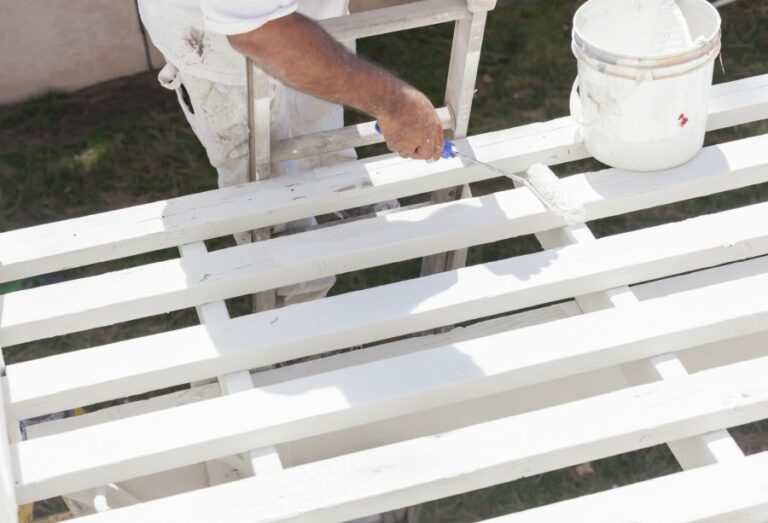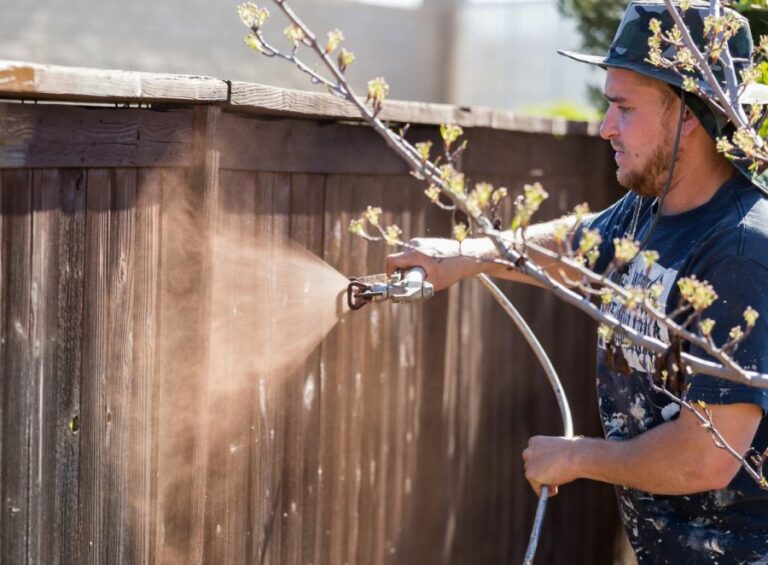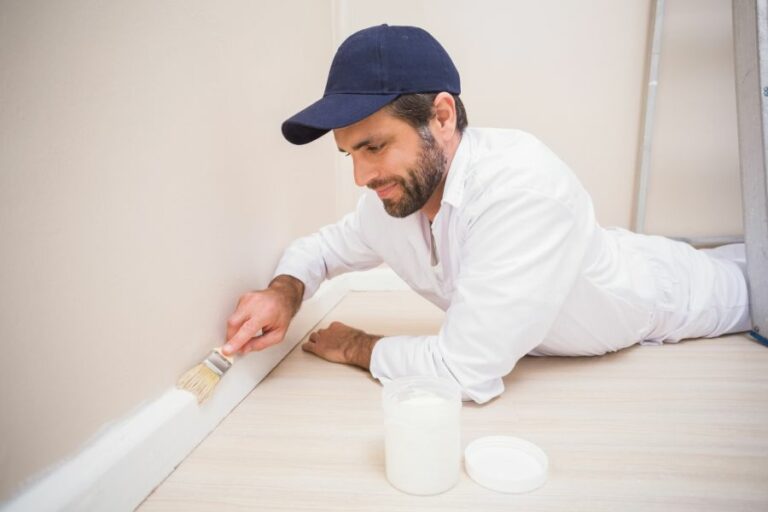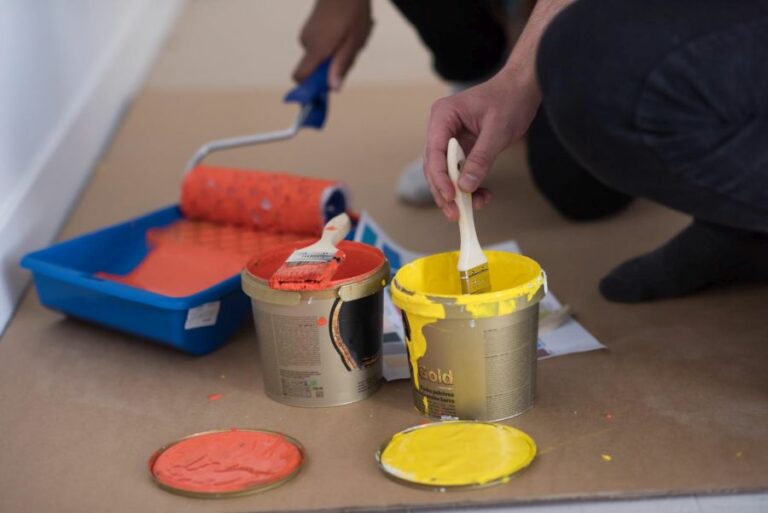Pressure Washing For Deep Exterior Cleaning. What Pros Say
Are you struggling to get rid of stubborn dirt, grime, and mildew from your home’s exterior surfaces? We have the perfect solution for you – pressure washing. This deep exterior cleaning technique will not only transform the appearance of your property but also ensure a safe and healthy environment for you and your loved ones.
Pressure washing for deep exterior cleaning:
Pressure washing is a highly effective method for deep exterior cleaning, removing dirt, grime, and mold from surfaces while increasing property value and providing a time-efficient, eco-friendly solution. To achieve optimal results, choose the appropriate pressure washer model, nozzle, and technique, practice safety measures, and maintain the equipment regularly.

Ready to make your home’s exterior look brand new? Dive into the world of pressure washing for deep exterior cleaning and witness a transformation. Keep reading to uncover the secrets of making your home shine!
Contents
- 1 Thorough Exterior Cleaning with Pressure Washing
- 2 Is a Pressure Washer Suitable for House Exterior Cleaning?
- 3 Determining the Right Pressure Washer Strength for Home Cleaning
- 4 Techniques for Pressure Washing High Areas on a House
- 5 Power Washing Your Home: Spring or Fall – Which is Best?
Thorough Exterior Cleaning with Pressure Washing
Pressure washing is an effective, efficient, and convenient way of cleaning the exterior surfaces of your home or property. This powerful cleaning method has a multitude of benefits, helping to restore sidings, driveways, walkways, and more to their original appearance.
• Benefits and Importance of Pressure Washing
Pressure washing is not just an aesthetic choice; it is also essential for maintaining the health of your home’s exterior surfaces. Some significant advantages of using pressure washing for deep exterior cleaning include the following:
– Removing Dirt, Grime, and Mold
Over time, dirt and grime can accumulate on your home’s siding, brickwork, and other surfaces, leading to an unsightly appearance. Mold and mildew can also grow, damaging these surfaces and jeopardizing the structural integrity of your property.
A properly executed pressure washing session can eliminate these harmful contaminants, restoring your home’s cleanliness and beauty.
– Increasing Property Value
Due to the improved appearance and removal of detrimental contaminants, pressure washing can help increase your property’s value. An expertly cleaned home not only appeals to potential buyers but also indicates that the property has been thoroughly cared for.
– Saving Time
Pressure washing is a fast and efficient cleaning method compared to manual scrubbing or using traditional cleaning tools. In just a few hours, a pressure washing session can restore multiple surfaces around your property, saving precious time and enhancing productivity.
– Eco-friendly Cleaning
Pressure washing uses water pressure and force to clean surfaces without the need for harmful chemicals. For eco-conscious property owners, this means minimizing environmental impact while performing potentially rigorous exterior cleaning tasks.
• Pressure Washing Equipment and Techniques
– Choosing the Right Pressure Washer
Pressure washers are available in different models and strengths, suitable for various applications. Light-duty models are appropriate for washing small surfaces, outdoor furniture, and vehicles, while medium-duty models are best suited for cleaning decks, fences, and siding.
Heavy-duty pressure washers are ideal for larger projects such as cleaning multi-story buildings and vast areas.
For effective deep exterior cleaning, it’s essential to choose a unit that provides the appropriate pressure for the specific cleaning task. It’s also essential to select a pressure washer with reliable safety features to prevent accidents or injury.
– Selecting the Right Nozzle
Pressure washer nozzles come in various sizes and spray patterns, and choosing the right one is crucial for deep exterior cleaning. The most common types include:
- Red nozzle (0): Delivers a narrow, high-pressure jet for removing stubborn stains
- Yellow nozzle (15): Provides a high-pressure spray for general cleaning tasks
- Green nozzle (25): Offers a medium-pressure spray ideal for surfaces not requiring high pressure
- White nozzle (40): Produces a low-pressure spray for delicate surfaces
Additionally, consider using a pressure washer nozzle with a rotating or oscillating spray pattern for enhanced cleaning power.
– Pressure Washer Techniques for Deep Cleaning
Once you’ve chosen the right pressure washer and nozzle, follow these tips for effective deep exterior cleaning:
- Preparation: Make sure all windows and doors are firmly closed before pressure washing. Apply detergent (if used) to the surface using a low-pressure spray, allowing it to work on the contaminants for a few minutes.
- Washing: Start pressure washing at the top of the surface, working your way downwards using side-to-side motions. Hold the nozzle at a distance of 6-12 inches from the surface, adjusting as necessary to prevent damage.
- Rinsing: After finishing pressure washing, thoroughly rinse the surface with clean water to remove any remaining soap or debris.
- Drying: Allow surfaces to air dry or use drying equipment such as leaf blowers to speed up the process.
– Safety Measures
Pressure washers are powerful machines, and it’s crucial to take safety measures when using them:
- Wear eye protection to shield against flying debris
- Wear sturdy shoes with a non-slip sole
- Keep your feet planted firmly on the ground and maintain proper balance
- Avoid spraying people or animals, as the pressure may cause injury
• Pressure Washing Maintenance
Regular maintenance of your pressure washer enhances its longevity and ensures optimal cleaning performance. After completing deep exterior cleaning tasks, follow these tips:
- Flush the system to remove any leftover detergent
- Disconnect water sources and spray the wand to release any remaining pressure or water
- Disconnect pressure washer hoses, accessories, and nozzles, storing them properly
- Clean and inspect any filters or screens
- Keep the pressure washer in a cool, dry storage area
In conclusion, pressure washing is an invaluable method for deep exterior cleaning, with numerous benefits and applications for homeowners and property managers.
By choosing the right equipment, practicing safety, and maintaining your pressure washer, you can maximize your investment and ensure beautiful, clean surfaces for years to come.
Is a Pressure Washer Suitable for House Exterior Cleaning?
When it comes to cleaning the exterior of your home, a pressure washer is a powerful tool that can transform the look of your house.
But the question remains, can you use a pressure washer to clean the outside of your house? The answer is yes, but there are certain precautions and best practices you should follow to ensure a safe and effective cleaning process.
• Benefits of Using a Pressure Washer
There are several benefits to using a pressure washer when cleaning the exterior of your home, including:
- Efficiency: Pressure washing is an incredibly efficient cleaning method compared to traditional scrubbing or using a garden hose. The powerful spray can remove dirt, grime, mold, and other contaminants from your siding with ease, without the need for excessive elbow grease.
- Time-Saving: Cleaning your home’s exterior with a pressure washer can save you a lot of time, as it covers large areas quickly and effectively.
- Water Conservation: Contrary to popular belief, pressure washing uses less water compared to hand-scrubbing or using a regular hose, thanks to the concentrated power of the water jet.
- Improved Curb Appeal: Regularly pressure washing your home’s exterior can keep it looking fresh and well-maintained, contributing to a higher property value and curb appeal.
• Siding Types and Pressure Washing
Not all siding types are compatible with pressure washing. Hence, it’s essential to understand which materials can be safely cleaned with a pressure washer and what you should avoid.
– Suitable for Pressure Washing:
- Vinyl siding
- Aluminum siding
- Brick
- Concrete
Before starting to pressure wash, make sure to inspect your siding for any damage or areas that need repair. Fix any issues first to prevent water from entering your home or causing further damage during the pressure washing process.
– Not Suitable for Pressure Washing:
- Wood siding
- Stucco
If your home has wood siding or stucco, it’s best to avoid using a pressure washer, as the powerful spray can cause damage to these delicate surfaces.
Instead, opt for a gentler cleaning method like hand-scrubbing with a soft-bristle brush and mild detergent or hiring professionals with experience cleaning these specific materials.
• Tips and Tricks for Pressure Washing Your Home
Follow these expert recommendations to ensure a safe and effective pressure-washing experience:
- Choose the Right Equipment: When selecting a pressure washer, look for a model with a range of pressure settings to offer the flexibility needed for various cleaning projects. For most residential applications, a pressure washer with 2,500 to 3,000 PSI (pounds per square inch) should be sufficient.
- Use Appropriate Nozzles: Pressure washer nozzles come in various sizes and spray patterns, and choosing the right one for your cleaning project is crucial. A 25-degree nozzle, often labeled as a green nozzle, is the recommended choice for most home siding cleaning projects.
- Prepare the Area: Before pressure washing your home, make sure to clear the area of any potential hazards or obstacles, and cover any electrical fixtures, like outdoor outlets or lights, to prevent water damage.
- Start with Low Pressure: When beginning the pressure washing process, start with low pressure and gradually increase it, depending on how dirty the siding is and how the surface responds to the cleaning.
- Use a Cleaning Solution: For a more effective cleaning process, consider applying a detergent or cleaning solution specifically designed for exterior home siding. Using the soap nozzle on your pressure washer or a separate pump sprayer, apply the solution to your siding, then rinse it off using the pressure washer.
- Avoid Spraying at an Upward Angle: When pressure washing your siding, always spray at a downward angle to prevent water from getting behind the siding, which can cause damage or rot.
- Keep a Safe Distance: Hold the pressure washer wand at least 12 inches away from your siding to prevent causing any damage or uneven cleaning results.
- Wear Safety Gear: To protect yourself during the cleaning process, wear eye protection, gloves, and appropriate footwear.
With these tips and an understanding of which siding types are compatible with pressure washing, you can effectively and efficiently use a pressure washer to clean the outside of your house.
Question | Answer |
|---|---|
Can you use a pressure washer to clean the outside of a house? | Yes, a pressure washer can be used to clean the exterior of a house. However, care should be taken to select the appropriate pressure setting, nozzle, and cleaning solution to avoid damaging the house’s siding, windows, or other surfaces. |
Determining the Right Pressure Washer Strength for Home Cleaning
Pressure washing can be an effective and efficient way to clean the exterior of your home. It helps remove built-up dirt, grime, algae, and other organic growth that can present not only an appearance problem but may also damage surfaces if left untreated.
• Understanding Pressure Washer Measurements
Pressure washers are categorized with two main measurements: Pounds per Square Inch (PSI) and Gallons per Minute (GPM). PSI refers to the pressure output created by the washer, while GPM measures the water flow delivered during the cleaning process.
Both measurements are critical and play a role in determining the overall effectiveness of the pressure washer.
– PSI
Higher PSI values mean the pressure washer has more concentrated cleaning power. Depending on the surface and level of dirt, various PSI levels can be suitable for different cleaning tasks. Here’s a general guideline for different cleaning requirements:
- 1000-1900 PSI: Suitable for light cleaning tasks (washing cars, outdoor furniture, and small decks).
- 2000-2900 PSI: Fit for medium-duty cleaning jobs (fences, sidewalks, and driveways).
- 3000-4000 PSI: Designed for heavy-duty cleaning tasks (large decks, exterior walls, and even stripping paint).
– GPM
GPM is critical because it determines the amount of water needed to wash away the dirt and grime that has been detached due to the pressure applied.
Higher GPM values offer a better rinsing capability, which can save time and water during cleanup. Most residential pressure washers have GPM values ranging from 1.2 to 4.0.
• Choosing the Right Pressure Washer for Your Home
– Electric Pressure Washers
When considering how strong a pressure washer you need for cleaning your home, it’s essential to start by reviewing electric pressure washers. These units typically have a PSI range of 1000 to 2000, which is suitable for lighter cleaning tasks.
They are ideal for cleaning small areas like outdoor furniture, BBQ grills, or vehicles but may struggle when attempting to clean larger surfaces, such as house siding.
– Gas Pressure Washers
Gas-powered pressure washers typically have a higher PSI range (2000 to 4000) and increased GPM capabilities compared to electric units. This higher power output makes them more suited for larger cleaning tasks, including effective pressure washing your home’s exterior.
Gas pressure washers provide the strength needed to tackle stubborn dirt and algae growth and even remove peeling paint without damaging surfaces.
– Pressure Washer Attachments
In addition to PSI and GPM values, consider using specialized attachments that can facilitate the cleaning process. A surface cleaner attachment, for instance, can cover a larger area and distribute the pressure more evenly, thus preventing damage to surfaces.
Similarly, using an adjustable pressure nozzle allows for better control and precision during cleaning, ensuring a safe and effective result.
• Recommended Pressure Washer Strength for Home Cleaning
Based on the information above, a gas-powered pressure washer with PSI values between 2000 and 3000, as well as GPM values between 2.0 and 2.5, should provide sufficient power to clean most home exteriors effectively.
This strength is suitable for removing built-up dirt and algae on surfaces such as vinyl, brick, and stucco, ensuring a clean and well-maintained appearance.
– Additional Considerations
While selecting the correct strength for your pressure washer is crucial, it’s also essential to local research regulations regarding water usage and environmental impact. Some regions may have specific guidelines for pressure washer usage, which might affect your choice.
Moreover, when pressure washing your home, ensure you follow safety precautions such as wearing appropriate protective gear, keeping a safe distance from the surfaces being cleaned, and utilizing a steady stroke to prevent damage to surfaces.
Finally, if you have concerns or require more guidance, consult with a pressure-washing professional. They can provide expert advice and recommendations based on their experience (Earthwise).
Techniques for Pressure Washing High Areas on a House
Efficiently pressure washing high areas of a house can be a daunting task. However, following proper techniques and using appropriate equipment will help ensure your house looks pristine and prevent any potential damage.
• Safety Comes First
Before beginning the pressure washing process, consider the following safety precautions to prevent accidents:
- Wear Appropriate Gear: Protect yourself from high-pressure spray and debris by wearing safety goggles, gloves, and non-slip shoes.
- Inspect the Area: Keep an eye out for any potential hazards, such as power lines or loose roofing materials.
- Avoid Working on Wet Surfaces: Wet surfaces can be extremely slippery, increasing the risk of falls. Make sure to work on dry surfaces or wait for them to dry.
• Choose the Right Equipment
Selecting the right equipment is crucial to perform an efficient and safe pressure washing job. Crucial components include:
– Pressure Washer
Opt for a gas-powered pressure washer with a minimum pressure of 2,500 psi for residential use. Higher psi ratings are suitable for commercial applications but can cause damage to your house if not used appropriately.
– Extension Wand
An extension wand allows you to easily reach high areas without straining yourself. These wands typically come in 12 to 24 feet options. It is essential to choose a wand with an appropriate length based on your specific needs.
– Nozzles
Different nozzle types are suitable for different surfaces, so selecting the correct nozzle is vital. A 25 or 40-degree angle nozzle is generally recommended for pressure washing high areas of a house since they provide a wider spray pattern and reduce the risk of damaging surfaces.
For more information on choosing the right pressure washer, refer to the Pressure Washer Buying Guide by Consumer Reports.
• Efficient Cleaning Techniques
Adopting proper cleaning techniques can help you achieve the desired result minus all the hassle.
– Soaking the Surface
Before starting with the pressure washing, wet the surface using a garden hose or spray nozzle. This step will loosen any dirt or debris, making the washing process more effective.
– Apply Detergent
It is best to use a detergent specifically designed for pressure washers. Detergents designed specifically for this purpose will help break down mold, mildew, and dirt, allowing for a more efficient cleaning job. Apply the detergent on the surface and let it sit for 5-10 minutes without letting it dry.
– Start Pressure Washing
Attach the extension wand to the pressure washer and make sure the correct nozzle is secured. Start pressure washing from the top, working your way down to avoid streaks.
Maintain a consistent distance from the surface (around 12-18 inches) to prevent damage. Use smooth, continuous strokes at a consistent pace for even coverage.
– Rinse Thoroughly
After pressure washing the high areas of your house, make sure to rinse off any residue by using the garden hose. A thorough rinse will not only wash off the detergent but also prevent streaks after the surface dries.
• Maintenance Tips
To prolong the life of your pressure washer and ensure it operates efficiently, follow these maintenance tips:
- Regularly Inspect: Check the pressure washer for any cracks, leaks, or loose parts regularly.
- Clean Nozzles: After each use, ensure that the nozzles are free of debris by rinsing them off with water.
- Proper Storage: Safely store your pressure washer and extension wand in a dry, cool area away from direct sunlight.
In conclusion, pressure washing in high areas of a house can be an easy and efficient task if the correct equipment and techniques are applied. Remember to always place safety first and follow proper cleaning procedures. With the right approach and practices, your house will look clean and well-maintained.
Power Washing Your Home: Spring or Fall – Which is Best?
Maintaining the cleanliness of the exterior of your house is essential for multiple reasons, including aesthetics, protection from harmful elements, and prevention of structural damage. One common method of cleaning the outside of a house is power washing.
• Pros of Spring Power Washing
– Allergy Relief
Spring is the season of allergies due to pollen and other allergens in the environment. Power washing your house in the spring helps remove allergens, leading to a decrease in allergy symptoms for you and your family.
The American College of Allergy, Asthma, and Immunology recommends regular house cleaning to mitigate allergy triggers.
– Enhanced Curb Appeal
Spring cleaning typically includes sprucing up the exterior of your home. Power washing your house in the spring gives you the benefit of a clean, fresh look that adds curb appeal and makes your property inviting to visitors.
– Early Detection of Damage
Power washing in the spring can expose any damage that occurs during the winter months. Early detection of issues, such as water leaks and cracked siding, allows you to address them before they become more severe, saving time and money on repairs.
• Cons of Spring Power Washing
– Busy Scheduling
Spring is a popular season for power washing, meaning that scheduling a professional service can be more challenging. If you’re planning to hire a professional, be prepared for potential scheduling conflicts.
– Temperature Fluctuations
Spring weather can be unpredictable, with temperature fluctuations causing water and cleaning solutions to freeze on your house’s exterior. It is essential to power wash on a day with consistent temperatures to avoid potential damage.
• Pros of Fall Power Washing
– Preparing for Winter
Cleaning your house’s exterior in the fall helps prepare it for winter by removing dirt, algae, and mold that might have accumulated during the warmer months. This allows your home to have a protective barrier against harsh winter weather and moisture.
– Less Busy Scheduling
Fall tends to be a less busy season for power-washing professionals. You might find it easier to schedule a service during this time and possibly even negotiate lower rates.
– Better Weather Conditions
Fall typically offers more consistent weather conditions, with cooler temperatures that reduce the risk of the water freezing on your house’s exterior during the power washing process.
• Cons of Fall Power Washing
– Less Daylight
As fall progresses, daylight hours decrease, which might make power washing more challenging if you’re attempting to complete the task yourself or need to schedule a professional within a specific timeframe.
– Prevalence of Leaves
Fall is the time when leaves drop from trees, which could end up sticking to your house’s wet exterior during the power washing process. You might need to clean these fallen leaves before and after power washing to avoid any complications.
• Expert Recommendations
Choosing between spring and fall for power washing largely depends on the specific needs and circumstances of your house, local weather conditions, and your personal preferences.
Both seasons have their benefits; however, if allergies are a concern, spring power washing might be the better choice. On the other hand, if you prefer scheduling flexibility and lower pricing, the fall season may be better suited to your needs.
In conclusion, power washing your house is an essential task that should ideally be performed at least once a year. Whether you choose to power wash in the spring or fall, regularly maintaining the cleanliness of your home’s exterior will benefit both its appearance and structural integrity.







